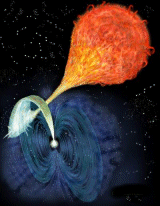AM Herculis star

Artist's impression of an AM Her system. Image © Russell Knightley Media.
An AM Herculis star is a type of magnetic cataclysmic binary that consists of a closely-orbiting dwarf M star or K star and a super-strong magnetic white dwarf primary, in which the magnetic field of the primary not only prevents the formation of an accretion disk but also synchronizes the primary's rotation with its orbital period. Such systems are the most extremely polarized objects known (hence their alternative name polars), exhibiting both strong linear and, more significantly, circular polarization. The powerful (10 to 100 megagauss) magnetic field of the white dwarf captures infalling material from the red dwarf before it can form an accretion disk and forces it instead into an accretion stream or funnel, one part of which heads for the star's north magnetic pole and the other for the south pole. As the field lines, like those around a bar magnet, converge, they channel the streams of matter onto tiny polar accretion spots. The streams slam into the white dwarf at some 3,000 kilometers per second and have their kinetic energy converted primarily into X-rays. The white dwarf's magnetic field also locks the spin of the two stars so that they always present the same face to each other (though in about one-tenth of AM Her stars, the white dwarf's axial and orbital rotations are off by about 1%). Furthermore, the magnetic field of the white dwarf often tilts over, so that one magnetic pole points toward the direction from which the stream comes (this being the lowest-energy configuration). As a result, material flows preferentially onto that pole.
Eclipses in AM Her systems provide a graphic illustration of this stream
geometry. Light curves reveal that the tiny, and thus rapidly eclipsed,
accretion spot at the stream-facing pole emits about half the total radiated
energy of the system, most of the rest coming from the extended stream,
which enters and leaves eclipse more gradually. The optical variations in
an AM Her star, described as "flickering," may range over 4 to 5 magnitudes.
The prototype, which lies in the constellation Hercules and has an orbital period of 3.1 hours, was discovered by Max Wolf in 1923, then listed in the General Catalogue of Variable Stars as
an irregular variable with a range from 12th to 14th magnitude. This listing
remained unchanged until 1976, when the true nature of AM Her began to emerge.
It was found to be the optical counterpart of an X-ray source, 3U 1809+50,
discovered by the Uhuru satellite. Some of the optical features of AM Her's
light curve are explainable in terms of the red dwarf secondary. First,
the red dwarf is distorted into an egg-shape by the attraction of its companion,
toward which the long axis of the egg points. When the secondary is seen
broadside, it appears slightly brighter than when end on; hence, as the
entire system rotates, there are two long, weak brightness maxima and two
long shallow minima per period. Second, there are sometimes brightness fluctuations
due to heating of the red dwarf's surface by X-rays from the primary. This
"hot spot" is periodically lost from view on the far side of the rotating
secondary. The short term flickering is due to the turbulent nature of
the mass transfer in the system.


